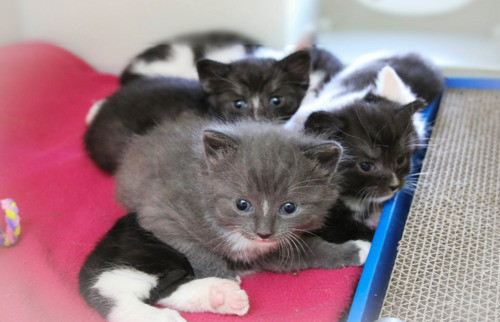Learn more about cat brothers and sisters
Do you have cat siblings at home? This Siblings Day, discover fascinating facts about feline brothers and sisters.
Share the sibling love by sending us photos of your littermates on Facebook, X (Twitter) and Instagram.
1. The largest litter had 19 kittens

When a mum cat gives birth she will normally have between four to six kittens. But in 1970, one cat in Oxfordshire in the UK gave birth to 19 kittens in one go! Sadly, four of the kittens were stillborn. But the poor mum still had 15 hungry mouths to feed! Let’s hope she was neutered after that ordeal.
2. Cats can mate with their siblings
Cats are able to mate when they reach four months old. If brothers and sisters are not neutered before this age, they can mate with each other to produce kittens. They can also mate with their parents too. This is why we recommend getting your cat neutered before they are four months old. Find out more about neutering.
3. Littermates can have different fathers

Some litters may contain half-brothers and half-sisters. It’s possible for kittens from the same litter to have different fathers. This can happen when female cats mate with more than one male over a short period of time. This means they get pregnant more than once to produce one litter.
4. Cats don’t remember their siblings for long
While they remain together, siblings and their mother will all recognise each other as being part of the same family. This is because they all have a shared family scent. But after the family has been separated for a while, this scent will change. It’s unlikely they would still recognise each other if they were reunited again in the future.
5. Siblings can be a variety of colours

Male kittens always inherit their fur colour from the mum, so brothers are likely to be similar colours. But female kittens will inherit a combination of their mum and dad’s colouring. Their coats can vary from their sisters’, especially if they have different dads! Find out why cats are different colours.
6. Littermates learn from each other

In their first few months of life, kittens will learn a lot from their brothers and sisters. One of the main things they practice with their littermates is how to hunt and play. This is why you might see kittens wrestling with each other. It can sometimes look a little aggressive. But as long as they’re taking equal turns to chase and pounce on each other, then it’s a great way for them to learn new skills.
7. Cats don’t get littermate syndrome
Littermate syndrome is thought to be a condition that makes it difficult for animals who are raised together to socialise with others. It’s believed that animals with littermate syndrome bond more closely with each other than any other siblings or human carers. This can lead to them developing behavioural problems in adulthood. But there is no evidence that littermate syndrome occurs in cats or dogs.
Do sibling cats get along?

You might assume that brother and sister cats will get along and live together happily. But this isn’t always the case. Cats don’t reach social maturity until they are between 18 months and four years old. Even if they get along when they are young, they may drift apart as they grow older.
Signs that your sibling cats get along:
- they groom each other
- they rub against each other
- they sleep touching each other
If you don’t see these signs, your cats may only be tolerating each other. But if your cats really don’t get along, you may notice these signs:
- blocking essential items such as food, water, beds and litter trays from each other
- only using essential items when the other cat isn’t around
- living in separate areas of the house from each other
- getting aggressive with each other
The stress associated with difficult sibling relationships can result in behavioural problems or even medical issues.
While there is no fix for getting your cats to be best mates again, there are some simple things you can do to help them live together happily. How to help your sibling cats get along.



